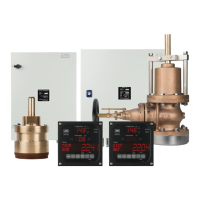6-37
6 NMEA filtering
Inputs are filtered according to a filter-file. The table below describes input filtering when
filter-file
NMEAfilterT_rev.txt is in use. The question mark “?” is used as a wildcard and
can be replaced by any character.
NMEA talkers Not filtered messa
es are startin
with:
LOG 1 MAIN VD; PSAL
LOG 1 REDUNDANCY VD; PSALS; PSALD; PSALW
LOG 2 VD; PSAL
GYRO (ROT) ??ROT
ES SDDPT; SDSTN
ESD SD; VDTXT; PSALC
SD4 PSALS,0; PSALS,1; PSALS,2; PSALS,3; PSALS,4;
PSALR; PSALC; VDTXT; ??ACK
ALARM MUTE ??ACK; ??HBT; ??ACN
GPS G??
GYRO (HDT) ??HDT
GYRO (ROT+HDT) ??HDT; ??ROT
OTHER Not
et implemented
Table 4 NMEA talker list
This table is stored in a filter-file that is specific for the system type chosen in menu S1.
The filter-files also contain NMEA output filtering according to NMEA listeners table below.
There are totally three default filter-files in the Sig. Distributor application:
NMEAfilterT_rev.txt, NMEAfilterR1a_rev.txt and NMEAfilterDual_rev.txt.
Example: a T-series system will use the file
NMEAfilterT_rev.txt.
Note! The filter-files shall never be changed and are only changeable when M13 is changed
and only for development purposes.
The filter-file type in use can be imported / exported to an USB memory stick. Using the menu
M6 CONF TO USB the Sig. Distributor will create a folder on the USB memory stick named
LPU2store_restore and export (copy) the filter-file in use from the Sig. Distributor into the
LPU2store_restore folder on the USB memory stick.
A filter-file can be imported into the Sig. Distributor using menu M5 CONF. FROM USB. The
USB memory stick has to have a folder named
LPU2store_restore on the root where the
filter-file is placed.

